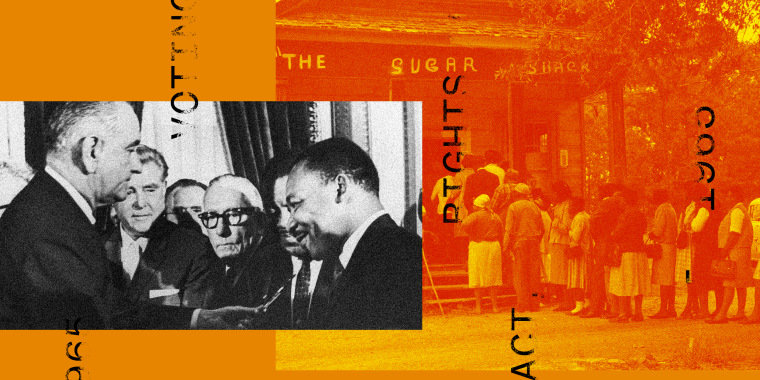
By Dean Obeidallah, MSNBC Opinion Columnist – (Source: www.msnbc.com) – Civil rights in America are far from a given when Black Americans had more voting rights in 1965 than they do today.
As it stands, America is less of a democracy today than it was in 1965.
If this meeting conjures up the civil rights movement in the early 1960s, you would not be far off. In fact, the Black community — along with other communities of color — have less protections today when it comes to voting access than they did in 1965. That’s not hyperbole; that’s a cold, hard fact given that in 2013 the GOP-controlled U.S. Supreme Court gutted key protections of the 1965 Voting Rights Act (VRA). Since that court decision to the present day, GOP-controlled states have implemented laws designed to make it more difficult for people of color to vote.
As a practical matter, that meant every change that states or VRA-covered localities wanted to make regarding voting — from voter registration to reducing polling stations to changes in election laws — the burden was on them to prove that the proposed voting measures did “not deny or abridge the right to vote on account of race, color, or membership in a language minority group.” If they couldn’t make that case, the measure was not permitted.
The VRA was influential in preventing Jim Crow 2.0 — which is why Republicans wanted to end it.
The VRA was influential in preventing Jim Crow 2.0 — which is why Republicans wanted to end it. Republican officials in Alabama brought a lawsuit, Shelby County v. Holder, that made its way to the Supreme Court in 2013 to declare that the formula used to determine which states were subject to the VRA’s preclearance requirement was out of date and therefore unconstitutional. At the time, the VRA’s “covered jurisdictions” comprised nine states — Alabama, Alaska, Arizona, Georgia, Louisiana, Mississippi, South Carolina, Texas and Virginia — and municipalities in six other states: California, Florida, Michigan, New York, North Carolina and South Dakota.
In this abomination of a court ruling, Chief Justice John Roberts, along with the five GOP-appointed Supreme Court justices, wrote, “The conditions that originally justified these measures no longer characterize voting in the covered jurisdictions.” This is as laughable as saying America was “post-racial” after Barack Obama was elected president.
Even more telling is that literally within hours of the Shelby decision, GOP officials in Texas implemented a strict voter ID measure that had previously been blocked under Section 5 after a federal court found it would have a discriminatory impact on people of color. It wasn’t long until other GOP states celebrated the gutting of the VRA by enacting a string of restrictive laws, such as in North Carolina, another state that had been under purview of the VRA, where Republicans cut back on early voting, reduced the window for voter registration and imposed voter ID requirements.
When Section 5 was in effect, the burden was on the state to prove the laws were not discriminatory before the measures were allowed to go into effect.
In the years that followed, the states that had been covered by the VRA at the time of the Shelby decision enacted laws to make it more difficult to vote, from closing over 1,500 polling locations to imposing additional voting ID requirements despite no showing of fraud.
And this year, we’ve seen a desperate GOP enact over 20 laws in 14 GOP-controlled states to restrict voting rights, per the Brennan Center for Justice. Many of these measures were enacted or proposed in states that were subject to the VRA’s preclearance requirement before the Shelby decision, such as Georgia, Texas and Arizona.
To be clear, the gutting of Section 5 of the VRA doesn’t mean that states can enact laws to expressly discriminate based on race — that is still unconstitutional. But when Section 5 was in effect, the burden was on the state to prove the laws were not discriminatory before the measures were allowed to go into effect. Now challenging discriminatory laws — as the Brennan Center notes — is “more difficult, expensive, and time-consuming” since private citizens or advocacy organizations are generally the ones that are now required to file lawsuits after the law takes effect, which can take years to be decided.
As it stands, America is less of a democracy today than it was in 1965. And that appears to be exactly what the GOP wants.

 On Tuesday, a cadre of the nation’s top
On Tuesday, a cadre of the nation’s top
Be the first to comment